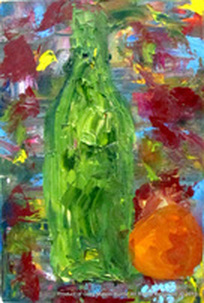
Una Vista de Ardales – oil on canvas
So I recently finished a successful Kickstarter campaing (see here). It was a small project to help raise money to buy frames for an exhibit, and it was my first ever fundraising campaign. Below are some lessons that I learned about how to run a successful Kickstarter campaign, and I hope that they help you in your Kickstarter, or other crowdfunding, campaign. Best of luck to you, and I hope that you more than exceed my success rate.Please note that these tips are only based on my experience, and that others may have better advice. I always feel that I can learn something new, so these tips may change over time. Having said that, here’s what I learned:

Barcelona Rooftops – oil on canvas
Know Your Backers
- There are a lot of people out there who say that the crowdfunding site that you’ll use will provide you your audience, and depending on who you are and what you’re trying raise money for, this is only true to some degree. Don’t take it for granted that the website will provide your audience. If they do, then great – you’ll be swimming in gravy when your project is successfully funded. But what if the site doesn’t provide? Unfortunately this is much more common, and what it means is that you need to raise money from your own base first. Of my 35 backers I knew about 25 of them, or at least had some sort of connection with them (either personally or via various forms of web forum). That 25 represented more than 90% of my total money raised. (If this raises an eyebrow for you and makes you ask why you’d pay for Kickstarter to help you raise money instead of an e-mail campaign that would cost you nothing then you’re missing two important pieces that Kickstarter and other sites provide: transparency and legitimacy. But that’s another post).
- Facebook provided about 50% of my funds, with about 30% coming from unknown sources. This is important because this is mostly how I advertised or got the word out there. Since I connect with my friends via FB, that’s how they got to my project page. But I didn’t just advertise to my friends. I posted on my fan page and other FB groups related to art. I have no clue which pages worked or where the unknown 30% came from, but I do know that people responded to some degree. These groups didn’t provide a lot (maybe 15% of my total), but it was something.
- I also posted on various chat forums related to both art and stamps and postcards. The first is obvious because these are people who know art and this was an art project. The latter options are because one of the rewards I offered was a postcard sent from Brasil with my art on it. I bought postcards here in Brasil, painted and drew on the back of them, and sent them out via the regular mail, thus they all have a Brasilian stamp on them. Collectors like this sort of thing, so I also hit them up, too. I had limited success here, however this particular rewards was the most popular one chosen, so at least I know the reward was a good one – I just didn’t hit the right audience or in I didn’t hit them in the most appropriate way.

Untitled Abstract #3 – oil on canvas
Small Donations Work Best
- I had donations running from $1 to $500 for my project. The average donation was $25, but the most popular reward chosen was $17. No one donated more than $100, and of my 35 backers only four donated $50 or more, and only eight donated $36 or more. This means a few things: first, people prefer to donate smaller amounts, especially when it’s an internet fundraiser. I know 100% of all of those who donated $50 or more and all but one of those who donated $36 or more. Of course, it could mean that my more costly rewards weren’t as attractive or didn’t offer a good enough value for supporters to take the plunge. There’s no way for me to know that without some sort of direct feedback, but I have noticed this same trend with all other Kickstarter projects that I’ve donated to in the past: their bread and butter were almost always $25 and under. Be realistic about what you think will sell. If you’re raising $2500 and offer rewards starting at $750 then you’ll likely fail, especially if you don’t have a large audience to draw from already. Of course, this always depends on you, your project, and what you’re trying to do, but when I think of how to run a successful Kickstarter campaign, I think of who can give what, not just what I want.

Four Bottles – oil on canvas
How to Post Your Kickstarter Link on FB
- OK – so this last point is really geared toward people who know the basics of how to post links on FB (in the status update section, for example). For some, this may sound simple, but for others try to play around with posting various types of links to see what I’m talking about. It is, however, important. When one pastes to FB an URL from a webpage with a video on that page, FB posts the link in the status update area and opens a box below the status update area with an image of the video. This is also true with images and not just videos, but with videos something happens that’s different from images: one can watch the video on FB without going to the page where the video exists for real. In other words, whenever I posted my Kickstarter project’s URL, because it has a video on the Kickstarter page, the video would show up on FB below the status update. Some of you may think, “That’s great!” except that it isn’t. Yes, people can watch the video on FB, but it also means they don’t need to go to your Kickstarter page, which is the whole point. I had SEVERAL people tell me that they watched the video but didn’t know how to donate. In other words, don’t take it for granted that people will know that they need to click on the link to go to the site. Many will just watch the video without knowing that they need to click the link. This could have an affect on your project. I’m sure it did on mine, and I didn’t figure this out until it was too late. I was able to rescue one donator who specifically asked how to get to the page, but several others, as I learned later, fell through the cracks due to this basic mistake.So what to do then? Well, one of the great things that Kickstarter has is that it allows you send updates to people following the project. Why is this important? Because these update pages don’t have videos. You can add images to your updates to make them look better, which is what I did since my project was an art project (but all projects could use images effectively in this way). What this means is that I would write an update, add an image to it, and then post that update’s link on FB. What would happen? Instead of a video that people could play on FB, there was an image – and when someone clicked on the image (ANYWHERE on the image) it automatically took them to the update page. And the great thing about that is that the rewards still show up on the right-hand side of the update page just as they do on the main project URL. So if you want to drive people to your page via FB, don’t post the video. Post only an update with an image.

Bottle with Orange – oil on canvas
Build Your Audience
- If you want to run a successful Kickstarter campaign, this final piece speaks to keeping your new audience in the fold for the future. When creating rewards, offer to your lowest donators a thank-you e-mail. For example, if you say that for $10 your supporter can receive a personal thank-you e-mail from you once the project is finished. What does this do? It allows you to add them to your e-mail list for future projects, fundraising or not. So if you’re rolling out a new line, or starting a new campaign then you’ll have their info at hand already. Of course, they may not participate in the future, but it’s a better bet to know that you can contact someone who has donated in the past than to rely on an unknown for the future.
So that’s it for advice for now. I may add to this as time goes on. Hopefully this helps you. Best of luck to you with regards to your project. I hope you break the bank, especially now that you know how to run a successful Kickstarter campaign.
Greg